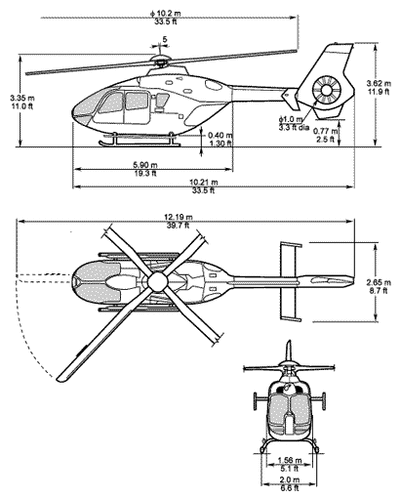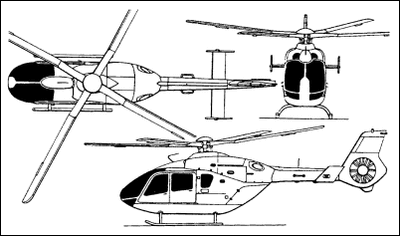The Goggle Case Rolled Off His Lap To The Left And He Reached For It. As He Did, The Helicopter Pitched Violently Forward
Location: Hampstead, NC Accident Number: ERA25LA126
Date & Time: February 24, 2025, 19:45 Local Registration: N930NH
Aircraft: Eurocopter Deutschland GMBH EC 135 P2+ Injuries: 3 Serious
Flight Conducted Under: Part 135: Air taxi & commuter - Non-scheduled - Air Medical (Discretionary)

On February 24, 2025, about 1945 eastern standard time, a Eurocopter Deutschland GMBH EC 135P2+, N930NH, was destroyed when it was involved in an accident near Hampstead, North Carolina. The pilot, flight paramedic, and flight nurse were seriously injured. The helicopter was operated as a Title 14 Code of Federal Regulations Part 135, positioning flight.
The helicopter, callsign "AirLink1" (AL1), was operated by Integra Aviation LLC. dba Apollo MedFlight for Novant Health’s AirLink air ambulance program which provided air medical services in both North and South Carolina.
The flight, destined for Albert J Ellis Airport (OAJ), Jacksonville, North Carolina, departed NHRMC-Ed North Heliport (45NR), Wilmington, North Carolina about 1938 after off-loading a patient from an interfacility transfer flight, and refueling. According to preliminary air traffic control (ATC) information, after liftoff, AL1 contacted the control tower at Wilmington International Airport (ILM), Wilmington, North Carolina about 1939. Local Control (LC) acknowledged and AL1 stated that they were off 45NR landing OAJ. LC acknowledged and instructed AL1 to remain south of runway 24 and ident. LC advised AL1; they had radar contact 3 miles southwest of ILM. LC then advised AL1 again that they had radar contact 3 miles southwest of ILM at 600 feet. AL1 acknowledged the altitude. LC then instructed AL1, visual flight rules (VFR) at pilot's discretion. AL1 acknowledged and advised LC they were climbing up to 1,000 feet. LC acknowledged.

At 1940, LC cleared AL1 on course with a restriction to remain east of runway 17. AL1 acknowledged. At 1943, LC instructed AL1to contact Wilmington Approach (WAP) on frequency 135.75. AL l acknowledged. AL1 then checked in with WAP. WAP acknowledged and cleared AL1 on course. AL1 acknowledged.
At 1944, WAP requested AL1report altitude.
At 1945, WAP called LC. WAP and LC discussed the possibility that AL1 was in coast track and might have gone down. WAP called AL1 with no response. LC called AL1 with no response. LC again called AL1 with no response or ident. LC then contacted a company helicopter, callsign “AirLink 2” (AL2) and asked if they had communication with AL1. AL2 stated they would call AL1.
At 1946, WAP called AL1 with no response. LC and AL2 discussed the situation and WAP called LC to discuss AL2 searching for AL1. LC acknowledged. WAP then asked other aircraft to look for AL1 and supplied a position. They advised no contact. WAP acknowledged. LC then called AL1 once again with no response.
Aircraft in the area, as well as state and local authorities were then contacted with the last contact information, flight route information, and possible location information. According to the pilot, after refueling, he lifted off and headed out of the New Haven Regional Medical Center towards the northeast, staying on the east side of runway 17/35 at ILM as instructed by ATC and stayed below 600 feet to avoid a conflict with departing traffic. Once clear of the airport traffic area, he climbed to 1,000 feet enroute back to their base at OAJ. He had the autopilot on and was wearing his night vision goggles (NVGs). Shortly after reaching 1,000 feet, the NVGs with the mount came off the visor of his helmet and were hanging by the battery pack cord. He then disconnected the NVGs from the battery pack and had them in his lap. He then reached over his head, grabbed the strap for the night vision goggle case that was hanging on the backside of the pilot's seat. He pulled that over his head (or around the
side) and opened the NVG storage bag and put the goggles and the battery pack along with the mount in the case. He could not remember if he zipped the case closed or not, but at some point, the goggle case rolled off his lap to the left and he reached for it. As he did, the helicopter pitched violently forward and started a descent.
The pilot then tried to regain control of the helicopter, and remembered the helicopter entering the trees, then at some point, his memory went blank. He stated that his next memory was of him standing next to the helicopter. He could not remember how he got out of the helicopter but remembered standing next to it. He also remembered the flight nurse and him working to free the flight paramedic who was trapped in the front left seat of the helicopter (the helicopter was on its left side). He also remembered pulling the instrument console off the flight paramedic while the flight nurse pulled the flight paramedic free. They next moved the flight paramedic to a nearby tree, where the three of them sat down and collected their thoughts about what happened and to rest. The pilot had his cell phone on him at the time, and was able to make a call, and send a ping of where their present position was so they could be rescued.
According to the flight paramedic, they had reached an altitude of 1,000 feet and the pilot engaged the autopilot. The flight was uneventful until the pilot’s NVGs fell off. He offered to help him put them back on. He could not remember what exactly the pilot said to him, but it was similar to, "I am going to just take them off because we are not taking another flight."

The pilot then took the night vision goggles off his helmet and put them in his case, which he had in front of him. The flight paramedic could not completely recall but that is when the helicopter went into a nosedive. The pilot pulled them out of the nosedive and the flight paramedic remembered that it was incredibly dark. He did not see anything for the first couple of seconds. Then he remembered seeing trees and then going into the trees. The pilot said, "hold on guys" and he felt the nose of the aircraft go up like the pilot was flaring to cushion the impact. He covered his face with his arms and remembered feeling every impact with the trees. He also remembered feeling them hit the ground and the dash coming down on his legs, and mud and water hitting him on the face and then everything stopped.
According to the flight nurse, she was sitting on the pilot side aft facing seat. They lifted off. All their seat belts were on.
The pilot had done the preflight check list. All things were normal, and there were no caution lights. The pilot had communicated to flight operations that they were approximately 25 minutes from their base at OAJ. As they were flying back to base the pilot was communicating with ATC. She then heard a conversation between the pilot and the flight paramedic concerning the NVG mount falling off the pilot’s helmet. The flight paramedic then asked the pilot if he would like him to fix his goggles and the pilot replied, "I am all set." "I will put them back in the bag." Right after the conversation, there was a huge loss of altitude. She asked the pilot what just happened, and he asked her if she was ok back there, and she said, "our stuff is everywhere back here, but I am fine." There was a moment when she felt everything would be okay. She was still belted in and surveying what was happening. She then heard a scraping noise, and the pilot said, "guys hang on." She remembered them going through
trees, dirt and water was flying, and there was lots of noise. When they came to rest, the helicopter was on its left side, and she was hanging from her seatbelt. She then popped her seatbelt off and dropped into the water, then after a short delay was able to egress.
Once she got out, the first thing she did was ask the flight paramedic for his cell phone and he said he did not have his. She then asked the pilot for his cell phone, and he pulled it out of his pocket and handed it to her. She went to his call list and found a name she knew. She then called the individual and told him they had been in a crash, they were alive, the pilot had a broken leg, and the flight paramedic’s leg was also broken, and he was trapped. The individual had a radio and called flight operations and communicated that they were all alive.
While they were waiting for rescue, she asked the pilot what happened. He replied, "I dropped the NVG bag on the collective." The pilot then apologized, and both she and the flight paramedic said it was ok and that neither of them was mad at him. They later were rescued, and the flight paramedic was freed from the wreckage by the flight nurse and flight paramedic from AL2, some hunters, and two North Carolina State Highway Patrol troopers.
According to FAA, and company records, the pilot held a commercial pilot certificate with ratings for airplane single-engine land, rotorcraft-helicopter, and instrument airplane and helicopter. He had accrued approximately 2,080 total flight hours, of which 1,556 hours were in rotorcraft, 24 hours was in the make and model of helicopter, 365 hours was at night, 290 hours were in actual instrument conditions, and 158 hours were in simulated instrument conditions. His most recent FAA first class medical certificate was issued on June 10, 2024.
According to FAA and helicopter maintenance records, the helicopter was manufactured in 2006. The helicopter’s most recent continuous airworthiness inspection was completed on February 4, 2025. At the time of the inspection, the helicopter had accrued approximately 12,179.2 total hours of operation.
The recorded weather at ILM, at 1953, approximately 5 minutes after the accident, included: calm wind, 10 miles visibility, clear skies, temperature 7° C, dew point 4° C, and an altimeter setting of 30.02 inches of mercury.
Sunset occurred at 1804 and the end of civil twilight occurred at 1829. Around the time of the accident, the Sun was more than 22° below the horizon and the Moon was more than 62° below the horizon. Dark nighttime conditions prevailed.
The wreckage was retained for examination.
 TikToker Arrested After Landing His C182 in Antarctica
TikToker Arrested After Landing His C182 in Antarctica Classic Aero-TV: Versatile AND Practical - The All-Seeing Aeroprakt A-22 LSA
Classic Aero-TV: Versatile AND Practical - The All-Seeing Aeroprakt A-22 LSA ANN's Daily Aero-Term (06.27.25): Hazardous Weather Information
ANN's Daily Aero-Term (06.27.25): Hazardous Weather Information ANN's Daily Aero-Linx (06.27.25)
ANN's Daily Aero-Linx (06.27.25) Aero-News: Quote of the Day (06.27.25)
Aero-News: Quote of the Day (06.27.25)





